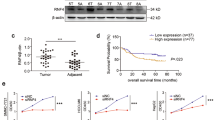Abstract
Objectives
To investigate the roles of Dead end 1 (Dnd1) in modulating cancer stem cell-related traits of hepatocellular carcinoma (HCC).
Results
Dead end (Dnd1) inhibited spheroid formation, suppressed the expression of stemness-related genes, and increased sensitivity to sorafenib in HCC cells. Mechanistically, Dnd1 could bind to 3′-UTR of LATS2, the key kinase of Hippo pathway, thus elevating LATS2 mRNA stability and its expression, subsequently leading to phosphorylation of YAP and its cytoplasmic retention. As a result, epithelial–mesenchymal transition (EMT) was weakened and therefore the generation of HCC stem cell properties was suppressed.
Conclusions
Dnd1 functions as a tumor suppressor by prohibiting CSC-like characteristics via activating Hippo pathway in HCC cells. Dnd1 could thus be a novel therapeutic target for HCC patients.





Similar content being viewed by others
References
Basu S, Totty NF, Irwin MS, Sudol M, Downward J (2003) Akt phosphorylates the Yes-associated protein, YAP, to induce interaction with 14-3-3 and attenuation of p73-mediated apoptosis. Mol Cell 11:11–23
Camargo FD, Gokhale S, Johnnidis JB, Fu D, Bell GW, Jaenisch R, Brummelkamp TR (2007) YAP1 increases organ size and expands undifferentiated progenitor cells. Curr Biol 17:2054–2060
Chiba T, Kita K, Zheng YW, Yokosuka O, Saisho H, Iwama A, Nakauchi H, Taniguchi H (2006) Side population purified from hepatocellular carcinoma cells harbors cancer stem cell-like properties. Hepatology 44:240–251
Dean M, Fojo T, Bates S (2005) Tumour stem cells and drug resistance. Nat Rev Cancer 5:275–284
Dontu G, Abdallah WM, Foley JM, Jackson KW, Clarke MF, Kawamura MJ, Wicha MS (2003) In vitro propagation and transcriptional profiling of human mammary stem/progenitor cells. Genes Dev 17:1253–1270
Hansen CG, Moroishi T, Guan KL (2015) YAP and TAZ: a nexus for Hippo signaling and beyond. Trends Cell Biol 25:499–513
Kedde M, Strasser MJ, Boldajipour B, Vrielink JAO, Slanchev K, le Sage C, Nagel R, Voorhoeve PM, van Duijse J, Orom UA et al (2007) RNA-binding protein Dnd1 inhibits microRNA access to target mRNA. Cell 131:1273–1286
Lei QY, Zhang H, Zhao B, Zha ZY, Bai F, Pei XH, Zhao S, Xiong Y, Guan KL (2008) TAZ promotes cell proliferation and epithelial–mesenchymal transition and is inhibited by the hippo pathway. Mol Cell Biol 28:2426–2436
Li Z, Wang Y, Zhu Y, Yuan C, Wang D, Zhang W, Qi B, Qiu J, Song X, Ye J et al (2015) The Hippo transducer TAZ promotes epithelial to mesenchymal transition and cancer stem cell maintenance in oral cancer. Mol Oncol 9:1091–1105
Liu X, Wang A, Heidbreder CE, Jiang L, Yu J, Kolokythas A, Huang L, Dai Y, Zhou X (2010) MicroRNA-24 targeting RNA-binding protein DND1 in tongue squamous cell carcinoma. FEBS Lett 584:4115–4120
Mani SA, Guo W, Liao MJ, Eaton EN, Ayyanan A, Zhou AY, Brooks M, Reinhard F, Zhang CC, Shipitsin M et al (2008) The epithelial–mesenchymal transition generates cells with properties of stem cells. Cell 133:704–715
Poon RTP, Fan ST, Wong J (2000) Risk factors, prevention, and management of postoperative recurrence after resection of hepatocellular carcinoma. Ann Surg 232:10–24
Scheel C, Weinberg RA (2012) Cancer stem cells and epithelial–mesenchymal transition: concepts and molecular links. Semin Cancer Biol 22:396–403
Torre LA, Bray F, Siegel RL, Ferlay J, Lortet-Tieulent J, Jemal A (2015) Global cancer statistics, 2012. CA Cancer J Clin 65:87–108
Visvader JE, Lindeman GJ (2008) Cancer stem cells in solid tumours: accumulating evidence and unresolved questions. Nat Rev Cancer 8:755–768
Yamaji M, Jishage M, Meyer C, Suryawanshi H, Der E, Yamaji M, Garzia A, Morozov P, Manickavel S, McFarland HL et al (2017) DND1 maintains germline stem cells via recruitment of the CCR4-NOT complex to target mRNAs. Nature 543:568–572
Zheng L, Li X, Gu Y, Lv X, Xi T (2015) The 3′-UTR of the pseudogene CYP4Z2P promotes tumor angiogenesis in breast cancer by acting as a ceRNA for CYP4Z1. Breast Cancer Res Treat 150:105–118
Author information
Authors and Affiliations
Corresponding authors
Ethics declarations
Conflicts of interest
The authors declare no conflict of interest.
Supporting information
Supplementary Table 1—Primer sequences used for PCR.
Electronic supplementary material
Below is the link to the electronic supplementary material.
Rights and permissions
About this article
Cite this article
Xu, W., Gong, F., Zhang, T. et al. RNA-binding protein Dnd1 inhibits epithelial–mesenchymal transition and cancer stem cell-related traits on hepatocellular carcinoma cells. Biotechnol Lett 39, 1359–1367 (2017). https://doi.org/10.1007/s10529-017-2375-5
Received:
Accepted:
Published:
Issue Date:
DOI: https://doi.org/10.1007/s10529-017-2375-5




